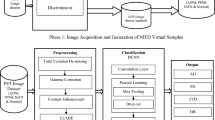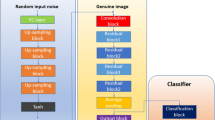Abstract
Alzheimer’s patients necessitate consistent support from caregivers or family members, highlighting the urgency for advanced technologies to aid in their daily lives through early disease detection. Consequently, there has been substantial research and development of machine learning-based systems aimed at assisting Alzheimer’s patients. However, ensuring the protection of the sensitive and personal data utilized in these systems remains a critical concern. In this context, Membership Inference Attack poses a severe threat to the privacy of targeted models. This research focuses on enhancing the preservation of data privacy during the training phase. We conducted vulnerability testing on a Transformer deep-learning model against Membership Inference Attack and developed a defense strategy to mitigate its impact. To achieve this objective, we evaluated the studied attack on Transformer model using two datasets: DemCare and Oasis. These datasets contain sensitive and personal information, underscoring the need for their utmost protection. Subsequently, we proposed a defense strategy based on dropout and residual connections. Through comparative experiments, our proposed strategy demonstrated significant improvements (i.e. 20.97% and 18.43%) over the previous model, providing efficient results. Thus, we can confidently conclude that our defense approach enhances data privacy and effectively mitigates the impact of the analyzed attack.
















Similar content being viewed by others
Data availability
Data sharing not applicable to this article as no datasets were generated or analyzed during the current study.
References
Bakkouri I, Afdel K (2020) Computer-aided diagnosis (cad) system based on multi-layer feature fusion network for skin lesion recognition in dermoscopy images. Multimed Tools Appl 79(29–30):20483–20518
Bakkouri I, Afdel K (2022) Mlca2f: multi-level context attentional featurefusion for covid-19 lesion segmentation from ct scans. Signal, Image and Video Processing 1–8. https://doi.org/10.1007/s11760-022-02325-w
Bentley JW, Gibney D, Hoppenworth G, Jha SK (2020) Quantifying membership inference vulnerability via generalization gap and other model metrics. arXiv preprint arXiv:2009.05669
Ben amida S, Mrabet H, Belguith S, Alhomoud A, Jemai A et al (2022) Towards securing machine learning models against membership inference attacks. Comput Mater Continua 70(3):4897–4919
Ben Hamida S, Mrabet H, Jemai A (2022) How differential privacy reinforces privacy of machine learning models? In Conference on Computational Collective Intelligence Technologies and Applications, pp 661–673. Springer
Caruccio L, Desiato D, Polese G, Tortora G, Zannone N (2022) A decision-support framework for data anonymization with application to machine learning processes. Inf Sci 613:1–32
De Gregorio G, Desiato D, Marcelli A, Polese G (2021) A multi classifier approach for supporting alzheimer’s diagnosis based on handwriting analysis. In Pattern Recognition. ICPR International Workshops and Challenges: Virtual Event, January 10–15, 2021, Proceedings, Part I, pages 559–574. Springer
Diogo VS, Ferreira Hugo Alexandre, Prata Diana, and for the Alzheimer’s Disease Neuroimaging Initiative (2022) Early diagnosis of alzheimer’s disease using machine learning: a multi-diagnostic generalizable approach. Alzheimers Res Ther 14(1):1–21
Dirgová Luptáková I, Kubovčík M, Pospíchal J (2022) Wearable sensor-based human activity recognition with transformer model. Sensors 22(5):1911
Duca AL (2021) Adversarial Machine Learning: Attacks and Possible Defense Strategies. https://towardsdatascience.com/adversarial-machine-learning-attacks-and-possible-defense-strategies-c00eac0b395a. Accessed 2022-11-16
Dwork C, Smith A, Steinke T, Ullman J (2017) Exposed! a survey of attacks on private data. Annu Rev Stat Appl 4(1):61–84
Ganju K, Wang Q, Yang W, Gunter CA, Borisov N (2018) Property inference attacks on fully connected neural networks using permutation invariant representations. In Proceedings of the 2018 ACM SIGSAC conference on computer and communications security, pp 619–633
Gong X, Wang Q, Chen Y, Yang W, Jiang X (2020) Model extraction attacks and defenses on cloud-based machine learning models. IEEE Commun Mag 58(12):83–89
Guide to Auc-Roc Curve in Machine Learning : What Is Specificity? - Analytics Vidhya. https://www.analyticsvidhya.com/blog/2020/06/auc-roc-curve-machine-learning/ Accessed 2023-01-11
Gupta U, Stripelis D, Lam PK, Thompson P, Ambite JL, Ver Steeg G (2021) Membership inference attacks on deep regression models for neuroimaging. In Medical Imaging with Deep Learning, pp 228–251. PMLR. https://proceedings.mlr.press/v143/gupta21a.html
Hayes J, Melis L, Danezis G, De Cristofaro E (2017) Logan: Membership inference attacks against generative models. arXiv preprint arXiv:1705.07663
Hendrycks D, Gimpel K (2016) Gaussian error linear units (gelus). arXiv preprint arXiv:1606.08415
He K, Zhang X, Ren S, Sun J (2016) Deep residual learning for image recognition. In Proceedings of the IEEE conference on computer vision and pattern recognition, pp 770–778
Homer N, Szelinger S, Redman M, Duggan D, Tembe W, Muehling J, Pearson John V, Stephan Dietrich A, Nelson Stanley F, Craig David W (2008) Resolving individuals contributing trace amounts of dna to highly complex mixtures using high-density snp genotyping microarrays. PLoS Genet 4(8):e1000167
Hongsheng H, Salcic Z, Sun L, Dobbie G, Yu PS, Zhang X (2022) Membership inference attacks on machine learning: A survey. ACM Comput Surv (CSUR) 54(11s):1–37
Jain P, Kulkarni V, Thakurta A, Williams O (2015) To drop or not to drop: Robustness, consistency and differential privacy properties of dropout. arXiv preprint arXiv:1503.02031
Jarray R, Snoun A, Bouchrika T, Jemai O (2021) Deep human action recognition system for assistance of alzheimer’s patients. In Hybrid Intelligent Systems: 20th International Conference on Hybrid Intelligent Systems (HIS 2020), December 14–16, 2020, pp 484–493. Springer
Karakostas A, Briassouli A, Avgerinakis K, Kompatsiaris I, Tsolaki M (2016) The dem@ care experiments and datasets: a technical report. arXiv preprint arXiv:1701.01142
Kaur P, Krishan K, Sharma SK, Kanchan T (2020) Facial-recognition algorithms: A literature review. Med Sci Law 60(2):131–139
Liu Q, Li P, Zhao W, Cai W, Shui Y, Leung VCM (2018) A survey on security threats and defensive techniques of machine learning: A data driven view. IEEE Access 6:12103–12117
Liu Y, Wen R, He X, Salem A, Zhang Z, Backes M, De Cristofaro E, Fritz M, Zhang Y (2022) ML-Doctor: Holistic risk assessment of inference attacks against machine learning models. In 31st USENIX Security Symposium (USENIX Security 22), pp 4525–4542
Marcus DS, Fotenos AF, Csernansky JG, Morris JC, Buckner RL (2010) Open access series of imaging studies: longitudinal mri data in nondemented and demented older adults. J Cogn Neurosci 22(12):2677–2684
Nasr M, Shokri R, Houmansad A (2019) Comprehensive privacy analysis of deep learning: Passive and active white-box inference attacks against centralized and federated learning. In Proceedings of IEEE Symposium on Security and Privacy (SP), pp 739–753
Praveen SP, Srinivasu PN, Shafi J, Wozniak M, Ijaz MF (2022) Resnet-32 and fastai for diagnoses of ductal carcinoma from 2d tissue slides. Sci Rep 12(1):20804
Rajasekar V, Premalatha J, Sathya K, Saračević M (2021) Secure remote user authentication scheme on health care, iot and cloud applications: a multilayer systematic survey. Acta Polytech Hung 18(3):87–106
Salem A, Zhang Y, Humbert M, Berrang P, Fritz M, Backes M (2018) Ml-leaks: Model and data independent membership inference attacks and defenses on machine learning models. arXiv preprint arXiv:1806.01246
Sarker IH (2021) Deep learning: a comprehensive overview on techniques, taxonomy, applications and research directions. SN Comput Sci 2(6):420
Shamshad F, Khan S, Zamir SW, Khan MH, Hayat M, Khan FS, Fu H (2023) Transformers in medical imaging: a survey. Med Image Anal 102802. https://doi.org/10.1016/j.media.2023.102802
Shokri R, Stronati M, Song C, Shmatikov V (2017) Membership inference attacks against machine learning models. In 2017 IEEE symposium on security and privacy (SP), pp 3–18. IEEE
Snoun A, Bouchrika T, Jemai O (2022) Deep-learning-based human activity recognition for alzheimer’s patients’ daily life activities assistance. Neural Comput Appl, pp 1–26. https://doi.org/10.1007/s00521-022-07883-1
Snoun A, Bouchrika T, Jemai O (2022) A reinforcement learning and transformers based intelligent system for the support of alzheimer’s patients in daily life activities. In 14th International Conference on Computational Collective Intelligence, pp 534–547. Springer
Snoun A, Bouchrika T, Jemai O (2022) View-invariant 3d skeleton-based human activity recognition based on transformer and spatio-temporal features. In ICPRAM, pp 706–715. https://doi.org/10.5220/0010895300003122
Snoun A, Jlidi N, Bouchrika T, Jemai O, Zaied M (2021) Towards a deep human activity recognition approach based on video to image transformation with skeleton data. Multimed Tools Appl 80(19):29675–29698
Sokolova M, Lapalme G (2009) A systematic analysis of performance measures for classification tasks. Inf Process Manage 45(4):427–437
Song C, Raghunathan A (2020) Information leakage in embedding models. In Proceedings of the 2020 ACM SIGSAC conference on computer and communications security, pp 377–390
Srivastava N, Hinton G, Krizhevsky A, Sutskever I, Salakhutdinov R (2014) Dropout: a simple way to prevent neural networks from overfitting. J Mach Learn Res 15(1):1929–1958
Truex S, Liu L, Gursoy ME, Lei Y, Wei W (2019) Demystifying membership inference attacks in machine learning as a service. IEEE Trans Serv Comput 14(6):2073–2089
Ulhaq A, Akhtar N, Pogrebna G,Mian A (2022) Vision transformers for action recognition: A survey. arXiv preprint arXiv:2209.05700
Vaswani A, Shazeer N, Parmar N, Uszkoreit J, Jones L, Gomez AN, Kaiser L, Polosukhin I (2017) Attention is all you need. Adv Neural Inf Process Syst 30. https://doi.org/10.48550/arXiv.1706.03762
Xiong R, Yang Y, He D, Zheng K, Zheng S, Xing C, Zhang H, Lan Y, Wang L, Liu T (2020) On layer normalization in the transformer architecture. In International Conference on Machine Learning, pp 10524–10533. PMLR. https://proceedings.mlr.press/v119/ xiong20b.html
Author information
Authors and Affiliations
Corresponding author
Ethics declarations
Conflict of interest
The authors declare that they have no conflict of interest.
Additional information
Publisher's note
Springer Nature remains neutral with regard to jurisdictional claims in published maps and institutional affiliations.
Rights and permissions
Springer Nature or its licensor (e.g. a society or other partner) holds exclusive rights to this article under a publishing agreement with the author(s) or other rightsholder(s); author self-archiving of the accepted manuscript version of this article is solely governed by the terms of such publishing agreement and applicable law.
About this article
Cite this article
Ben Hamida, S., Ben Hamida, S., Snoun, A. et al. The influence of dropout and residual connection against membership inference attacks on transformer model: a neuro generative disease case study. Multimed Tools Appl 83, 16231–16253 (2024). https://doi.org/10.1007/s11042-023-16126-x
Received:
Revised:
Accepted:
Published:
Issue Date:
DOI: https://doi.org/10.1007/s11042-023-16126-x




